Hey everyone!
I have a tube preamp that I decided to upgrade all the components to higher end stuff.
All components are still the same value but tighter tolerance but better components (PRP resistors, Nichicon fine gold capacitors and Mundorf Evo capacitors )
My issues are I lost most of my bottom end? Not sure what components caused the drop in low end maybe some experts here will have a idea?
The pre amp is a soundstage vacuum two preamplifier And I cant find any schematic on it is as well. I will post some before and after pictures of the components that were changed.
Thanks in advanced !
I have a tube preamp that I decided to upgrade all the components to higher end stuff.
All components are still the same value but tighter tolerance but better components (PRP resistors, Nichicon fine gold capacitors and Mundorf Evo capacitors )
My issues are I lost most of my bottom end? Not sure what components caused the drop in low end maybe some experts here will have a idea?
The pre amp is a soundstage vacuum two preamplifier And I cant find any schematic on it is as well. I will post some before and after pictures of the components that were changed.
Thanks in advanced !
Attachments
-
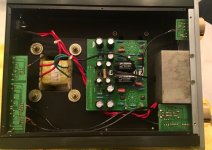 9E1EC7AB-756D-4E0C-A0B5-C5FB85532DEF.jpeg367.1 KB · Views: 149
9E1EC7AB-756D-4E0C-A0B5-C5FB85532DEF.jpeg367.1 KB · Views: 149 -
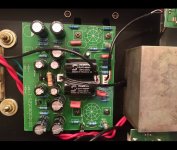 4A5E1D9D-AB04-4C04-ADB2-CBD2CA5860B8.jpeg419.7 KB · Views: 143
4A5E1D9D-AB04-4C04-ADB2-CBD2CA5860B8.jpeg419.7 KB · Views: 143 -
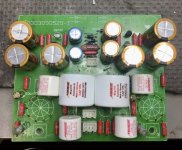 AD7E4B3A-669E-4790-A636-A485D72AD56F.jpeg150.9 KB · Views: 146
AD7E4B3A-669E-4790-A636-A485D72AD56F.jpeg150.9 KB · Views: 146 -
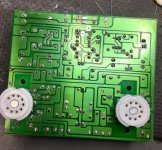 A03A2111-AED3-4F4A-9930-7DAF59AA00F5.jpeg559.9 KB · Views: 143
A03A2111-AED3-4F4A-9930-7DAF59AA00F5.jpeg559.9 KB · Views: 143 -
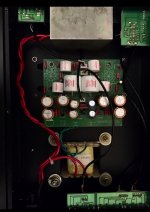 D649E031-FA70-4D8B-ABCF-92D48C0BF4CD.jpeg570.2 KB · Views: 136
D649E031-FA70-4D8B-ABCF-92D48C0BF4CD.jpeg570.2 KB · Views: 136
If all new caps/resistors/ components are the same values, it just needs time to break in. Need to keep on playing your preamp for a few days constantly or 1 or 2 weeks. Most of the Mundorf film caps take a lot of break-in time before the sound starts to open up. Just my .50 cent 🙂
No electronic component needs breaking in, thats an audiophile myth.
Might be best to at least measure the resistors with a multimeter to check their values are correct.
Inspect soldering for dry joints.
You may need to make some measurements to check the frequency response and audio levels (if possible).
Might be best to at least measure the resistors with a multimeter to check their values are correct.
Inspect soldering for dry joints.
You may need to make some measurements to check the frequency response and audio levels (if possible).
The perception of tonality is an controversial subject. What I mean is, a perception that seems to change even though the measured frequency response remains unchanged. I have experienced such an effect when the distortion profile of a circuit is altered. Circuits with very low distortion seem much less affected, which makes sense. I speculate that small changes is an amplifier's distortion profile can, psychoacoustically, draw attention to some areas of the audio band over other areas. Such as to instrument overtones versus their fundamentals, thereby giving the perception of an altered tonality, even though the measured frequency response remains unchanged. Should the upper midrange and treble range sound more prominent, then the lower midrange and bass range sounds relatively more reticent, and vice-versa.
I suggest that you first measure the frequency response so to verify that it has not inadvertently been changed by one of the component changes, if you have the capability to do so. Such as via a PC soundcard signal analyzer. Assuming that the FR is still flat, you will either have to accept the new perceived tonality, or reverse the component changes you had made. Also, consider that you had become used to the percieved tonality of the unit before the modifications, and so, it became your reference for how your unit should sound. I suggest giving the modified version some listening time to see of it begins to progressively sound better to you before embarking on the trouble of reversing those modifications.
I suggest that you first measure the frequency response so to verify that it has not inadvertently been changed by one of the component changes, if you have the capability to do so. Such as via a PC soundcard signal analyzer. Assuming that the FR is still flat, you will either have to accept the new perceived tonality, or reverse the component changes you had made. Also, consider that you had become used to the percieved tonality of the unit before the modifications, and so, it became your reference for how your unit should sound. I suggest giving the modified version some listening time to see of it begins to progressively sound better to you before embarking on the trouble of reversing those modifications.
Last edited:
This is not the first case in which someone became dissatisfied after having replaced good industrial grade components in a proven design by some of hyped, audiophoolish brands. Look at those physically huge axial capacitors. You had to bend their leads heavily to get them onto your PCB. Despite of that, they come very close to each other, which may call for oscillations and spoil the device's performance.
Best regards!
Best regards!